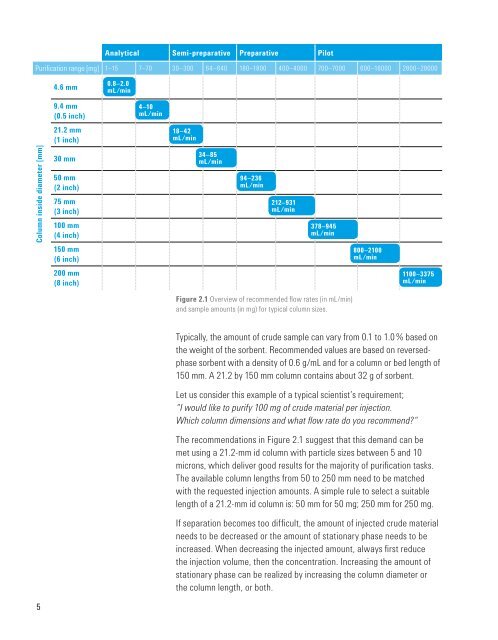Principles and Practical Aspects of Preparative Liquid Chromatography
Create successful ePaper yourself
Turn your PDF publications into a flip-book with our unique Google optimized e-Paper software.
Analytical Semi-preparative <strong>Preparative</strong> Pilot<br />
Purification range [mg] 1–15 7–70 30–300 64–640 180–1800 400–4000 700–7000 600–16000 2800–28000<br />
4.6 mm<br />
0.8–2.0<br />
mL/min<br />
9.4 mm<br />
(0.5 inch)<br />
21.2 mm<br />
(1 inch)<br />
4–10<br />
mL/min<br />
18–42<br />
mL/min<br />
Column inside diameter [mm]<br />
30 mm<br />
50 mm<br />
(2 inch)<br />
75 mm<br />
(3 inch)<br />
100 mm<br />
(4 inch)<br />
150 mm<br />
(6 inch)<br />
200 mm<br />
(8 inch)<br />
34–85<br />
mL/min<br />
94–236<br />
mL/min<br />
212–931<br />
mL/min<br />
378–945<br />
mL/min<br />
800–2100<br />
mL/min<br />
1100–3375<br />
mL/min<br />
Figure 2.1 Overview <strong>of</strong> recommended flow rates (in mL/min)<br />
<strong>and</strong> sample amounts (in mg) for typical column sizes.<br />
Typically, the amount <strong>of</strong> crude sample can vary from 0.1 to 1.0 % based on<br />
the weight <strong>of</strong> the sorbent. Recommended values are based on reversedphase<br />
sorbent with a density <strong>of</strong> 0.6 g/mL <strong>and</strong> for a column or bed length <strong>of</strong><br />
150 mm. A 21.2 by 150 mm column contains about 32 g <strong>of</strong> sorbent.<br />
Let us consider this example <strong>of</strong> a typical scientist’s requirement;<br />
“I would like to purify 100 mg <strong>of</strong> crude material per injection.<br />
Which column dimensions <strong>and</strong> what flow rate do you recommend?“<br />
The recommendations in Figure 2.1 suggest that this dem<strong>and</strong> can be<br />
met using a 21.2-mm id column with particle sizes between 5 <strong>and</strong> 10<br />
microns, which deliver good results for the majority <strong>of</strong> purification tasks.<br />
The available column lengths from 50 to 250 mm need to be matched<br />
with the requested injection amounts. A simple rule to select a suitable<br />
length <strong>of</strong> a 21.2-mm id column is: 50 mm for 50 mg; 250 mm for 250 mg.<br />
If separation becomes too difficult, the amount <strong>of</strong> injected crude material<br />
needs to be decreased or the amount <strong>of</strong> stationary phase needs to be<br />
increased. When decreasing the injected amount, always first reduce<br />
the injection volume, then the concentration. Increasing the amount <strong>of</strong><br />
stationary phase can be realized by increasing the column diameter or<br />
the column length, or both.<br />
5



